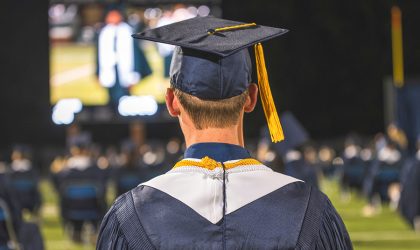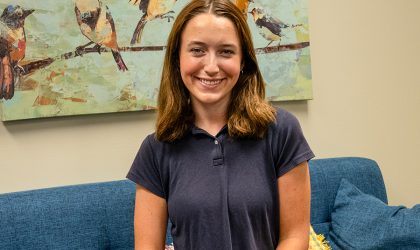
Beth Murray-Wilson, Allen Broyles, and Pat Taylor
Guest speaker Allen Broyles presented a session for faculty and staff February 1 from 3:15 p.m. – 4:15 p.m. on Cerebro Diversity and Diversified Learning. He led faculty and staff through exercises that demonstrated how memory is enhanced when touch or movement is incorporated; how it feels to a student to complete a task in an area of weakness; and how people interpret intelligence based on performance. He discussed how views of a person’s intelligence often are restricted to those associated with scholarly activity without accounting for other attributes of intelligence, such as spatial or verbal intelligence.
Throughout the day, he also met with small groups of faculty, staff, and administrators sharing current research and experiences regarding the ways individuals and classes learn best. Broyles routinely encourages educators to look for ways to incorporate new models of teaching that help all students learn more effectively. He said that even students who have no trouble with memorizing and giving info back learn better with hands on, multimodal, and multisensory experiences. He also finds that learning strategies that work for students with learning differences work for all students.
Broyles serves on the National Board of Directors of the Learning Disabilities Association of America, and has presented and consulted on the topics of brain research, math, and differentiation for Southern Association of Independent Schools and at regional and international conferences. He has 24 years of experience in independent school education in administration and in the classroom, and is currently assistant head of school at The Howard School in Atlanta.
 Using strategies presented by Allen Broyles yesterday, Middle School teacher Lisa Lucas modified a test review for her class. The students were going to review landforms, islands, and rivers of South America for a test this Thursday. Instead, the students drew and outlined (from memory) South America and then were given labels to write the names of 27 landforms, islands, and rivers (again from memory) and place them in the correct location on their map. Afterwards, they displayed their maps and checked one another’s work for mistakes. The students responded at the end they never thought they could do this when the teacher presented the instructions, but once they started, all groups were able to remember almost all 27 items and their locations. The students also shared they really enjoyed doing a hands-on review because it didn’t even feel like a review. The teacher enjoyed watching students work together to determine how they would design their map and coming up with all of the names. She also commented that it was particularly rewarding that students who are normally quiet during review time said that they had fun!
Using strategies presented by Allen Broyles yesterday, Middle School teacher Lisa Lucas modified a test review for her class. The students were going to review landforms, islands, and rivers of South America for a test this Thursday. Instead, the students drew and outlined (from memory) South America and then were given labels to write the names of 27 landforms, islands, and rivers (again from memory) and place them in the correct location on their map. Afterwards, they displayed their maps and checked one another’s work for mistakes. The students responded at the end they never thought they could do this when the teacher presented the instructions, but once they started, all groups were able to remember almost all 27 items and their locations. The students also shared they really enjoyed doing a hands-on review because it didn’t even feel like a review. The teacher enjoyed watching students work together to determine how they would design their map and coming up with all of the names. She also commented that it was particularly rewarding that students who are normally quiet during review time said that they had fun!


